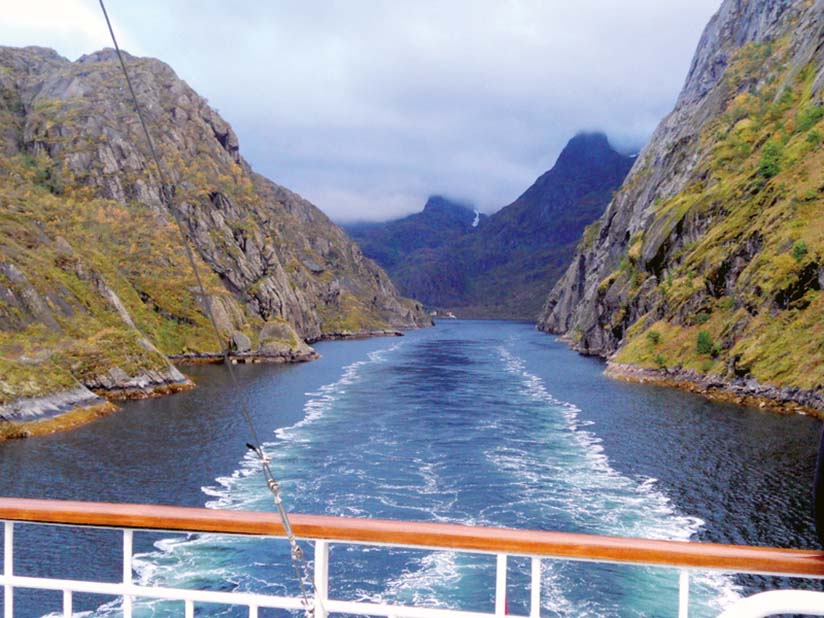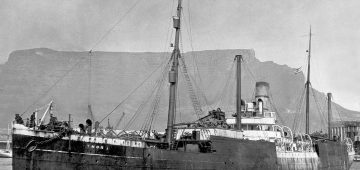From: Malcolm McRonald, by e-mail
The article by Norman Middlemiss on Coast Lines in the October issue was of great interest. However, I’m afraid that the caption under the photo of the Gloucester Coast on page 55 is partly incorrect.
The vessel alongside the Gloucester Coast is indeed named Dorset Coast. However, she is not the one built in 1908, but the later one built in 1924. There is a third ship in the photo, and that is the two-funnelled cruise ship Killarney, which began her cruising career and was painted in those cruising colours in 1927. This Dorset Coast was transferred to the Belfast Steamship Co. in 1929, so the photo must have been taken between March 1927, when the Killarney arrived at Liverpool prior to starting her cruise service and June 1929 when the Dorset Coast was transferred. This Dorset Coast was built by J. Towers Shipbuilding Co., of Bristol. She had been ordered by Walford Lines Ltd., who had intended to name her Reedham, but she was sold to Coast Lines before launch.On her transfer in 1929, she was renamed Logic and in 1935 she became Ulster Hero. In 1945 she was sold to J. & A. Gardner & Co. Ltd., of Glasgow and renamed Saint Conan. In 1958, she was broken up at Dublin.
The Killarney had been built in 1893 for the Belfast Steamship Co. Ltd. for its overnight service between Belfast and Liverpool. She was taken over by the Navy in 1914 as a hospital ship and served under the names Magic, Magic II and Classic. She was returned to the Belfast Steamship Co. in 1919, but retained the name Classic. In addition to her Belfast-Liverpool sailings, she spent three periods between 1921 and 1923 on charter to the City of Cork Steam Packet Co. Ltd. for operation on its Cork-Fishguard service. In 1924, she was transferred to the City of Cork Steam Packet Co. Ltd. and renamed Killarney, then operating permanently on the Cork-Fishguard service. She arrived at Cork on her final sailing from Fishguard on 25 March 1927 and next day sailed light to Liverpool, where she was re-registered. Her cruises were operated by Coast Lines, but the Killarney remained in the ownership of the Cork company until the end of December 1931, when she was transferred to Coast Lines. In March 1947, she was sold to the Bury Court Shipping Co. Ltd., of London and renamed Attiki. The next year she was sold to the Greek company Epirotiki Steamship Navigation Co. George Potamianos and renamed Adrias. She then operated inter-island sailings and cruises until 6th October 1951, when she was wrecked on Falconera Island, while voyaging from Crete to Piraeus.
I hope this information is of interest.

From: Bob Hughes, by e-mail
I loved the article on the Chefoo in the December edition – she lasted 32 years! I know life for British ships and their crews, could be difficult in Maoist China, as I’ve known older people who sailed for Blue Flue. The Scots skipper sounded a wonderful chap, shame he died so young. I loved his alloting of duties for 1st mate to the 3rd etc. I dare say, he could have charmed my irascible Liverpool Welsh chief engineer dad into co-operation. The war certainly had its effect. Dad was a junior engineer and during the war, he had pneumonia, a breakdown and finally malaria. When in hospital, with malaria, he met mum, who was a nurse. Consequently, I don’t complain about mosquito bites. Dad had been fourth engineer on Yeoward’s Avoceta in mid to late 1939, so he knew many of the crew that died when she was sunk. He always reacted badly to unexpected noises. His very good friend Olie Amudsen – yes, the explorer’s nephew, was like dad, a chief engineer with Booths. Olie would confine himself to his cabin for three days, with several bottles of whisky, for company. However, why he did it, was understood and tolerated. One of dad’s junior engineers, a Scots lad from the Western Isles, had sailed with China Navigation. Dad sailed on the Newbeach, the old Rosebank, on the China coast, in the mid 1970s. A deck cargo included 2,000 pigs, in crates! The pressure then, was young Chinese people wanting to practice their English. I loved the article on Lamports ‘R’ class. I saw Romney when I was a boy, bad winter of 1962/3. She looked fabulous. I went onboard one of the smaller ‘R’ ships, as dad was technically employed by Lamport and Holt but always sailed on Booth ships. He was the relief chief engineer. I remember being offered a very unappetising piece of steamed cod, for lunch. The steward was not amused, when I declined the food.

From: A. D. Frost, Sunderland
Having read about, and along with further reading about, the Union Castle R’s I feel that profile was later to be used to produce Royal Mail Lines Loch Loyal mainly that it bears a uncanny resemblance to her forebearers.
With regards to N. Middlemas “Forgotten Fleets” article on States Marine Lines, he failed to mention that they were the main company in establishing South African Marine Corporation (even the company sounds American bearing in mind the country was called U.S.A.), with the SA government, probably to break up the monopoly of the British Conference Lines, and with it shortened to Safmarine. The rest they say is history.The company is now part of the Maersk group although the name is carried on.

From: Stuart Edmond, by e-mail
I was greatly interested in Trevor Boult’s article on The Polarlys which appeared in the January edition. I did the same Hurtigruten trip in September 2015 but in the Nordlys (North Light). Like him, I was amazed by the breath-taking scenery and by the skill of the Captain and Officers of the ship in taking her through some astonishingly narrow channels. I attach a photo to show one of the narrowest we went through on that trip. The Captain said he did this one only in fine weather!
I was very impressed also by the very high standard of the crew all of whom were Scandinavians with impeccable English. Apparently, labour laws in Norway demand that local ships employ only crew from Scandinavian countries, which, given the comparatively high wages, probably accounts for the high degree of mechanisation on the Hurtigruten ships. Only one man was required on the foc’sle head for arrivals and departures, and he manipulated the capstans electronically from a little box hung round his neck rather like the old bus conductor’s ticket machine!
It was also interesting to learn that the present Hurtigruten Company is British-owned. As one ferry departs Bergen every evening at 1700 every day of the year, the whole operation must be very heavily subsidised and costly to maintain. This is probably why great efforts are now being made to make tourism a large part of Company’s income. They have realised that not all tourists want to do the intensive round trip involving calls, whether needed or not, at 32 ports out and back, and so now several ships operate a less intensive schedule allowing more time in fewer places.
The other abiding memory of Norway is the very impressive infrastructure and the large number of modern vehicular bridges under which the Hurtigruten ferries pass. Where did Britain go wrong!







Comments
Sorry, comments are closed for this item